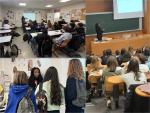Interacting particle systems are known for their ability to generate large-scale self-organized structures from simple local interaction rules between each agent and its neighbors. In addition to studying their emergent behavior, a main focus of the mathematical community has been concentrated on deriving their large-population limit. In particular, the mean-field limit consists of describing the limit system by its population density in the product space of positions and labels. The strategy to derive such limits is often based on a careful combination of methods ranging from analysis of PDEs and stochastic analysis, to kinetic equations and graph theory. In this article, we focus on a generalization of multi-agent systems that includes higher-order interactions, which has largely captured the attention of the applied community in the last years. In such models, interactions between individuals are no longer assumed to be binary (i.e. between a pair of particles). Instead, individuals are allowed to interact by groups so that a full group jointly generates a non-linear force on any given individual. The underlying graph of connections is then replaced by a hypergraph, which we assume to be dense, but possibly non-uniform and of unbounded rank. For the first time in the literature, we show that when the interaction kernels are regular enough, then the mean-field limit is determined by a limiting Vlasov-type equation, where the hypergraph limit is encoded by a so-called UR-hypergraphon (unbounded-rank hypergraphon), and where the resulting mean-field force admits infinitely-many orders of interactions.
N. Ayi, N. Pouradier Duteil, D. Poyato
2024
In this article, we study the large-population limit of interacting particle systems posed on weighted random graphs. In that aim, we introduce a general framework for the construction of weighted random graphs, generalizing the concept of graphons. We prove that as the number of par- ticles tends to infinity, the finite-dimensional particle system converges in probability to the solution of a deterministic graph-limit equation, in which the graphon prescribing the interaction is given by the first moment of the weighted random graph law. We also study interacting particle systems posed on switching weighted random graphs, which are obtained by resetting the weighted random graph at regular time intervals. We show that these systems converge to the same graph-limit equation, in which the interaction is prescribed by a constant-in-time graphon.
N. Ayi, N. Pouradier Duteil
2023
In this paper, we study a model for opinion dynamics where the influence weights of agents evolve in time via an equation which is coupled with the opinions’ evolution. We explore the natural question of the large population limit with two approaches: the now classical mean-field limit and the more recent graph limit. After establishing the existence and uniqueness of solutions to the models that we will consider, we provide a rigorous mathematical justification for taking the graph limit in a general context. Then, establishing the key notion of indistinguishability, which is a necessary framework to consider the mean-field limit, we prove the subordination of the mean-field limit to the graph one in that context. This actually provides an alternative (but weaker) proof for the mean-field limit. We conclude by showing some numerical simulations to illustrate our results.
N. Ayi, N. Pouradier Duteil
In Journal of Differential Equations,
2021
We provide a rigorous derivation of the linear Boltzmann equation without cut-off starting from a system of particles interacting via a potential with infinite range as the number of particles N goes to infinity under the Boltzmann-Grad scaling.
The main difficulty in our context is that, due to the infinite range of the potential, a non- integrable singularity appears in the angular collision kernel, making no longer valid the single- use of Lanford’s strategy.
Our proof relies then on a combination of Lanford’s strategy, of tools developed recently by Bodineau, Gallagher and Saint-Raymond to study the collision process, and of new duality arguments to study the additional terms associated to the long-range interaction, leading to some explicit weak estimates.
N. Ayi
In Communications in Mathematical Physics,
2017



